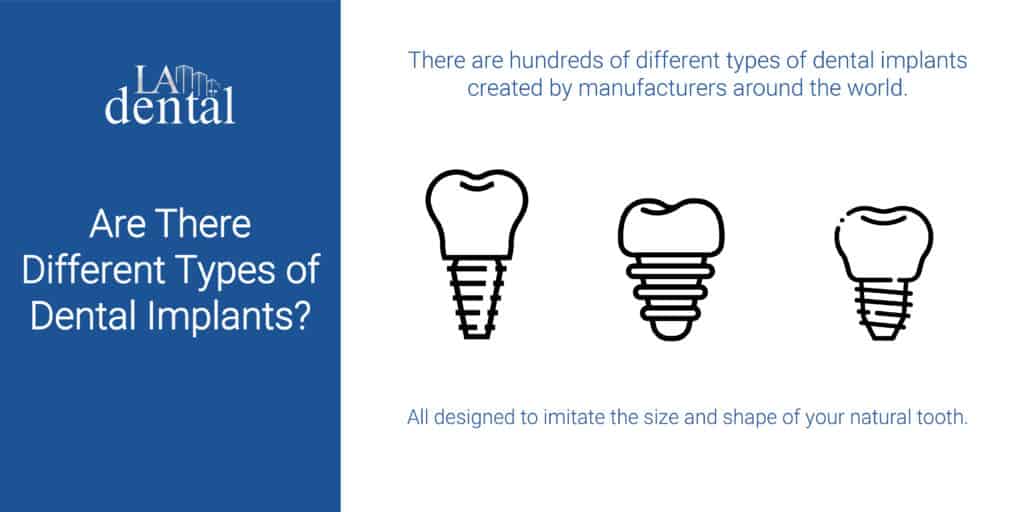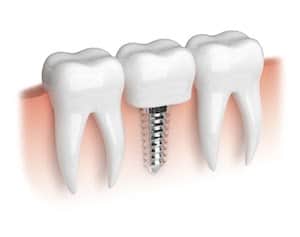Dental implants are an excellent way to replace missing teeth. They are the closest thing in dentistry to a natural tooth, both in appearance and functionality. There are a variety of different types of dental implants available on the market today. However, despite the different sizes, placements, and materials used, most implants take on relatively the same size and shape as a natural tooth.
Styles of Dental Implants
Implant dentistry falls under the field of restorative dentistry. When a patient is missing a tooth, due to an accident, illness, or age, your dentist is able to replace the missing tooth using a dental implant. There are hundreds of different types of dental implants, created by manufacturers around the world. Most of these are based on the same format, consisting of a screw-shaped base, which can vary in size and depth.
The screw’s shape is largely for stability so that it can stay in place in patients’ jaw. A small abutment attaches to the top of the implant and lastly, a crown is placed on top. This gives a realistic look to the implant and allows for it to function like a real tooth.
There are lots of different methods and implant designs that connect the implant to the actual crown. For example, some types of implants do not require an abutment and have that feature built-in. There are so many different dental implant manufacturers on the market today, it can be difficult to decide which type of dental implants are the most effective. Often, the design does not matter as much as the functionality, the patients’ needs, and how the implant is used.
Various Dental Implant Placements
There are two main types of dental implants. The first is called an endosteal implant and the second is a subperiosteal implant.
Endosteal Dental Implants
Endosteal dental implants are by far, the most common types of dental implants in the industry. These implants are placed directly into your jaw bone. They typically have screw-like features that help them stay in place.
Sometimes patients may require bone grafting before the implant is placed if they have experienced bone loss. Over time the jaw bone grows and adheres to the implant itself, making it almost as strong and sturdy as a natural tooth root.
Subperiosteal Dental Implants
Subperiosteal implants are less common but are still widely used in dentistry. Sometimes, if a patient does not have sufficient levels of bone density in the jaw, a subperiosteal implant is required. These types of implants are most frequently made entirely of metal and they are attached to the top of your jaw.
They sit under your gums and above the jaw bone. They do not sit within the bone itself, rather they rest on top of it. The metal framework contains implants which protrude out of the metal base.
Once the gums have healed around this type of implant, crowns can be attached to the protruding metal implants and they will feel secure. This type of implant is rare and it is reserved for the patients that have severe bone loss.
You can learn more about these two different types of dental implants at the American Academy of Implant Dentistry. Their article describes these two forms of implants in detail.
Different Dental Implant Materials
Titanium Implants
Dental implants generally come in two kinds of materials. The first, most widely used material, is titanium. Titanium is a unique metal in the sense that it is biocompatible. This means that it is accepted by the body, and when used as a dental implant, the natural jaw bone will grow well alongside the titanium, which will help to secure the implant. Titanium dental implants have been in use since the 1950s. They have been time tested and remain the most popular dental implant material today.
Zirconia Implants
The second common dental implant material is zirconia. Zirconia dental implants were invented more recently, in the early 2000s, and they are an excellent option for patients with metal allergies or sensitivities. Zirconia is a type of ceramic material and it does not corrode over time.
It is also porcelain-white in color, which makes it difficult to notice when a patient is smiling. Although it is not the most common implant material, zirconia implants are versatile and they seamlessly blend in with the rest of your teeth.
Visit LA Dental Clinic
If you have experienced tooth loss and are looking to rebuild the look and feel of your smile, dental implants may be an excellent option for you. At LA Dental Clinic we offer both endosteal and subperiosteal dental implants.
Our team can help to answer any additional questions you may have regarding the types of implant that is best suited to your specific needs. We can also assist with alternative methods of tooth replacement, such as bridges, dentures, and full-arch restoration. Contact us today or call at 213-385-9710.

